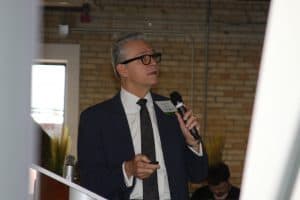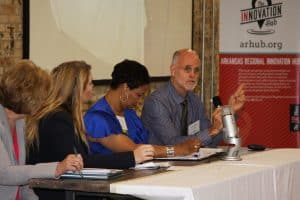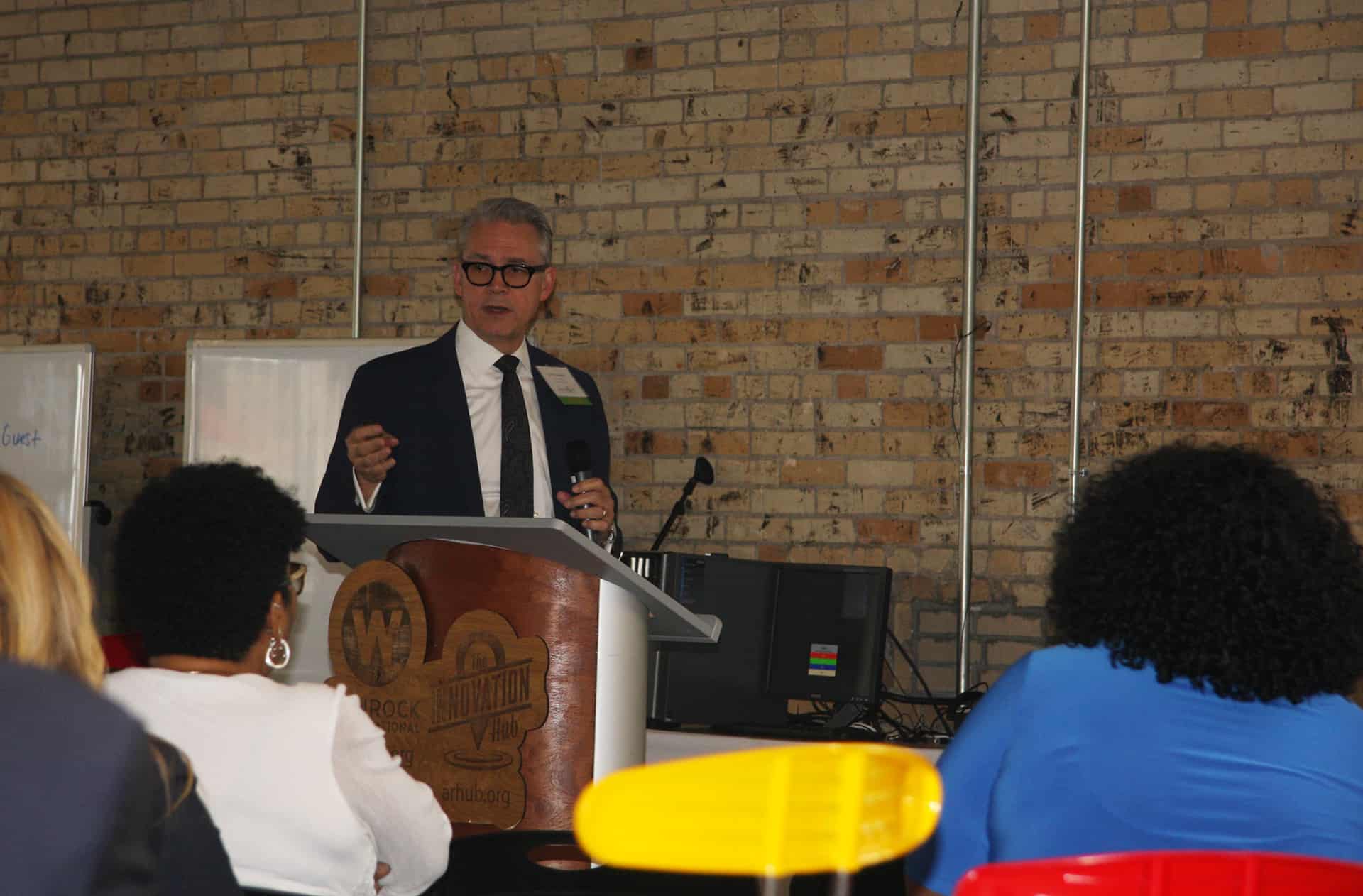Telemedicine’s Future Discussed at Innovation Summit
| July 12, 2017 | Nearly 200 Arkansas health care and business professionals gathered June 30 at the 2017 Telehealth Innovation Summit in North Little Rock to discuss the innovations, challenges and future of telemedicine.
The day-long event at the Arkansas Regional Innovation Hub amassed health care administrators, clinicians, IT managers, hospital billing specialists, office and business managers, and other health care professionals, including several UAMS staff and faculty.
Curtis L. Lowery, M.D., chair of the UAMS College of Medicine’s Department of Obstetrics and Gynecology, was a keynote speaker and highlighted recent advancements in telemedicine in Arkansas, including many programs at UAMS.
“UAMS is using technology to change the way medicine is practiced,” said Lowery, medical director of the UAMS Center for Distance Health. “By using video care delivery, remote patient monitoring and 24-hour patient access, we are building a new low-cost system of care that puts our patients’ needs first.”

Lowery, medical director of the UAMS Center for Distance Health, highlighted several programs in the center, including AR SAVES and ANGELS.
Lowery is the founder and director of ANGELS (Antenatal and Neonatal Guidelines, Education and Learning System), a program in the UAMS Center for Distance Health that assists high-risk pregnancies throughout the state. ANGELS allows UAMS obstetricians to consult with a patient via video, enabling the patient to receive health care close to home.
In 2016, ANGELS’ telemedicine staff conducted more than 3,300 visits at health care facilities and centers across the state for ultrasounds, colposcopies, fetal echocardiography and other pregnancy issues.
Lowery noted the success of another telemedicine program in the UAMS Center for Distance Health: Arkansas Stroke Assistance through Virtual Emergency Support (AR SAVES). The program provides 53 Arkansas hospitals with round-the-clock access to stroke neurologists who can quickly assess whether a stroke patient can be helped by a clot-busting drug that often restores complete function to the patient.
As of 2016, 84 percent of Arkansans lived within 30 minutes of an AR SAVES stroke hospital and 99 percent lived within an hour. Due to the success of the program, Arkansas recently fell to sixth in the nation in the number of stroke deaths per capita after many years in first place.
“AR SAVES has made a real difference in people’s lives,” said Lowery “This would have been difficult, and almost impossible, to do without telemedicine.”
Not only does telemedicine provide advantages to clinicians, said Lowery, it can educate other physicians in best practices and educate patients about their conditions, as well as open up opportunities to reach rural residents for research.

Thomas Kiser, M.D., a professor in the College of Medicine’s Department of Physical Medicine and Rehabilitation, answers a question during a panel discussion on telemedicine integration.
Thomas Kiser, M.D., a professor in the College of Medicine’s Department of Physical Medicine and Rehabilitation, was part of a panel of health care administrators that discussed integrating telemedicine into existing practices, the barriers involved and how to measure success.
Teague Johnson, a UAMS telemedicine specialist manager, and Allen Finne, UAMS network engineering director, discussed bandwidth requirements for optimal telemedicine, ways IT specialists and clinicians can communicate effectively, and how to schedule telemedicine training through the UAMS Center for Distance Health.
From the UAMS Center for Distance Health, Tina Benton, executive director of development; Roz Perkins, clinic manager; and Terri Imus, trauma staff coordinator; reviewed the telemedicine business model. They spoke about recent updates to the state’s telemedicine parity law, solutions to billing, reimbursement, licensure and credentialing issues, how to develop contractual agreements with providers, and how to expand the use of telemedicine to schools and detention centers.
The summit was hosted by Arkansas e-Link, a state broadband network created from a $102 million grant in 2010 to UAMS and partner institutions. Arkansas e-Link connects more than 400 telemedicine sites – including hospitals, medical, behavioral health and therapy clinics – and community colleges.
The network allows patients to consult in real time with medical specialists in other locations through interactive video so patients can receive needed health care near their homes.
Arkansas e-Link became a Rural Healthcare Connect Fund consortium leader in 2014, which allows members to apply for funding and receive cost savings on data circuits and networking equipment.
Roy Kitchen, Arkansas e-Link’s network director, said Arkansas e-Link has produced $29 million in savings on equipment and broadband connection for e-Link participants throughout Arkansas.
